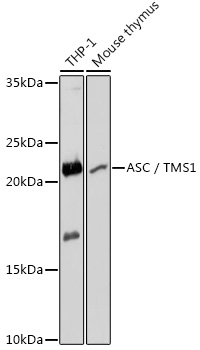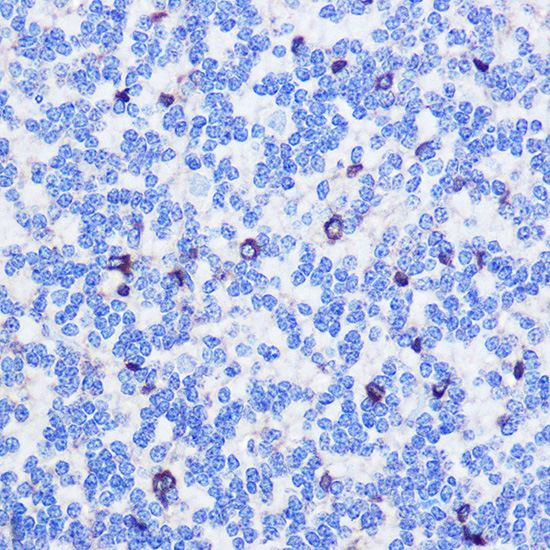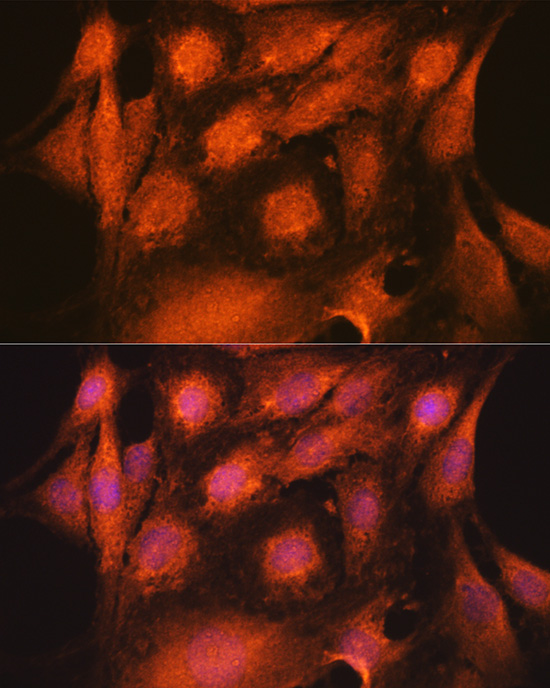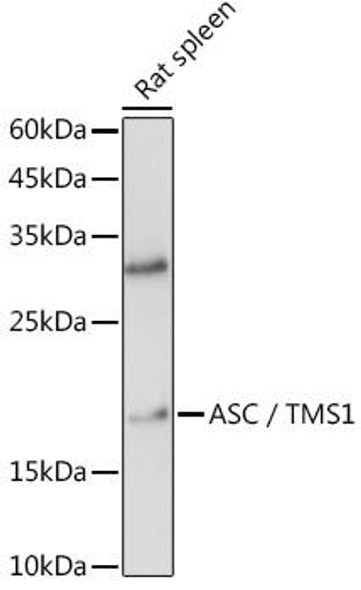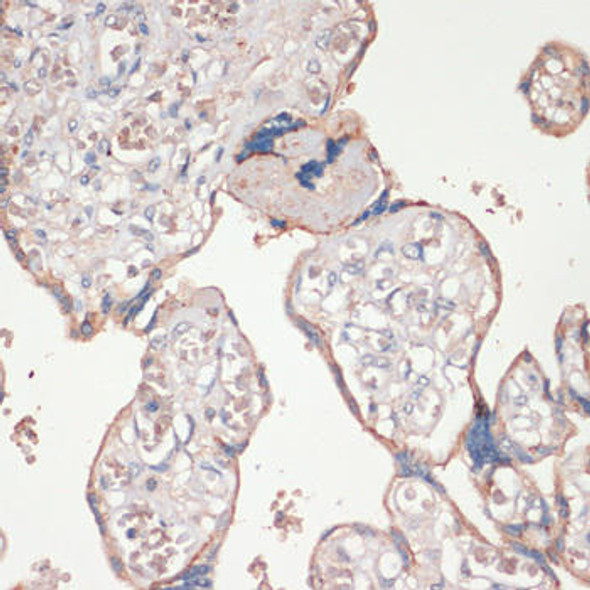Cell Death Antibodies 1
Anti-ASC / TMS1 Antibody (CAB11433)
- SKU:
- CAB11433
- Product Type:
- Antibody
- Reactivity:
- Human
- Reactivity:
- Mouse
- Reactivity:
- Rat
- Host Species:
- Rabbit
- Isotype:
- IgG
- Antibody Type:
- Polyclonal Antibody
- Research Area:
- Cell Death
Description
| Antibody Name: | Anti-ASC / TMS1 Antibody |
| Antibody SKU: | CAB11433 |
| Antibody Size: | 20uL, 50uL, 100uL |
| Application: | WB IHC IF |
| Reactivity: | Human, Mouse, Rat |
| Host Species: | Rabbit |
| Immunogen: | Recombinant fusion protein containing a sequence corresponding to amino acids 50-195 of human ASC / TMS1 (NP_037390.2). |
| Application: | WB IHC IF |
| Recommended Dilution: | WB 1:500 - 1:2000 IHC 1:50 - 1:200 IF 1:50 - 1:200 |
| Reactivity: | Human, Mouse, Rat |
| Positive Samples: | THP-1, Mouse thymus |
| Immunogen: | Recombinant fusion protein containing a sequence corresponding to amino acids 50-195 of human ASC / TMS1 (NP_037390.2). |
| Purification Method: | Affinity purification |
| Storage Buffer: | Store at -20'C. Avoid freeze / thaw cycles. Buffer: PBS with 0.02% sodium azide, 50% glycerol, pH7.3. |
| Isotype: | IgG |
| Sequence: | LDLT DKLV SFYL ETYG AELT ANVL RDMG LQEM AGQL QAAT HQGS GAAP AGIQ APPQ SAAK PGLH FIDQ HRAA LIAR VTNV EWLL DALY GKVL TDEQ YQAV RAEP TNPS KMRK LFSF TPAW NWTC KDLL LQAL RESQ SYLV EDLE RS |
| Gene ID: | 29108 |
| Uniprot: | Q9ULZ3 |
| Cellular Location: | Cytoplasm, Endoplasmic reticulum, Mitochondrion, Nucleus |
| Calculated MW: | 15kDa/19kDa/21kDa |
| Observed MW: | 21kDa |
| Synonyms: | PYCARD, ASC, CARD5, TMS, TMS-1, TMS1, PYD and CARD domain containing, ASC / TMS1 |
| Background: | This gene encodes an adaptor protein that is composed of two protein-protein interaction domains: a N-terminal PYRIN-PAAD-DAPIN domain (PYD) and a C-terminal caspase-recruitment domain (CARD). The PYD and CARD domains are members of the six-helix bundle death domain-fold superfamily that mediates assembly of large signaling complexes in the inflammatory and apoptotic signaling pathways via the activation of caspase. In normal cells, this protein is localized to the cytoplasm; however, in cells undergoing apoptosis, it forms ball-like aggregates near the nuclear periphery. Two transcript variants encoding different isoforms have been found for this gene. |
| UniProt Protein Function: | PYCARD: Promotes caspase-mediated apoptosis. This proapoptotic activity is mediated predominantly through the activation of caspase-9. May be a component of the inflammasome, a protein complex which also includes NALP2, CARD8 and CASP1 and whose function would be the activation of proinflammatory caspases. Forms complexes with other DAPIN domain-containing proteins. Interacts with CIAS1/PYPAF1 and PYDC1. Widely expressed at low levels. Detected in peripheral blood leukocytes, lung, small intestine, spleen, thymus, colon and at lower levels in placenta, liver and kidney. Very low expression in skeletal muscle, heart and brain. Detected in the leukemia cell lines HL-60 and U-937, but not in Jurkat T- cell lymphoma and Daudi Burkitt's lymphoma. Detected in the melanoma cell line WM35, but not in WM793. Not detected in HeLa cervical carcinoma cells and MOLT-4 lymphocytic leukemia cells. 3 isoforms of the human protein are produced by alternative splicing. |
| UniProt Protein Details: | Protein type:Tumor suppressor; Adaptor/scaffold Chromosomal Location of Human Ortholog: 16p11.2 Cellular Component: cell soma; mitochondrion; endoplasmic reticulum; cytoplasm; nucleolus; extracellular region; IkappaB kinase complex; cytosol; nucleus Molecular Function:protein binding; protein homodimerization activity; protease binding; caspase activator activity; Pyrin domain binding Biological Process: myeloid dendritic cell activation during immune response; apoptosis; positive regulation of apoptosis; regulation of protein stability; positive regulation of caspase activity; positive regulation of JNK cascade; positive regulation of interleukin-1 beta secretion; positive regulation of activated T cell proliferation; signal transduction; defense response to Gram-negative bacterium; activation of NF-kappaB transcription factor; tumor necrosis factor-mediated signaling pathway; positive regulation of phagocytosis; inflammatory response; DNA damage response, signal transduction by p53 class mediator resulting in induction of apoptosis; defense response to virus; positive regulation of adaptive immune response; caspase activation; interleukin-1 beta production; positive regulation of interleukin-6 production; negative regulation of I-kappaB kinase/NF-kappaB cascade; positive regulation of tumor necrosis factor production; negative regulation of interferon-beta production; myeloid dendritic cell activation; positive regulation of interferon-gamma production; positive regulation of actin filament polymerization; inhibition of NF-kappaB transcription factor; regulation of inflammatory response; innate immune response; regulation of autophagy; positive regulation of transcription factor activity; positive regulation of T cell activation; positive regulation of defense response to virus by host; activation of innate immune response; positive regulation of antigen processing and presentation of peptide antigen via MHC class II |
| NCBI Summary: | This gene encodes an adaptor protein that is composed of two protein-protein interaction domains: a N-terminal PYRIN-PAAD-DAPIN domain (PYD) and a C-terminal caspase-recruitment domain (CARD). The PYD and CARD domains are members of the six-helix bundle death domain-fold superfamily that mediates assembly of large signaling complexes in the inflammatory and apoptotic signaling pathways via the activation of caspase. In normal cells, this protein is localized to the cytoplasm; however, in cells undergoing apoptosis, it forms ball-like aggregates near the nuclear periphery. Two transcript variants encoding different isoforms have been found for this gene. [provided by RefSeq, Jul 2008] |
| UniProt Code: | Q9ULZ3 |
| NCBI GenInfo Identifier: | 18203507 |
| NCBI Gene ID: | 29108 |
| NCBI Accession: | Q9ULZ3.2 |
| UniProt Related Accession: | Q9ULZ3 |
| Molecular Weight: | 21 KD |
| NCBI Full Name: | Apoptosis-associated speck-like protein containing a CARD |
| NCBI Synonym Full Names: | PYD and CARD domain containing |
| NCBI Official Symbol: | PYCARD |
| NCBI Official Synonym Symbols: | ASC; TMS; TMS1; CARD5; TMS-1 |
| NCBI Protein Information: | apoptosis-associated speck-like protein containing a CARD |
| UniProt Protein Name: | Apoptosis-associated speck-like protein containing a CARD |
| UniProt Synonym Protein Names: | Caspase recruitment domain-containing protein 5; PYD and CARD domain-containing protein; Target of methylation-induced silencing 1 |
| Protein Family: | Ascalin |
| UniProt Gene Name: | PYCARD |
| UniProt Entry Name: | ASC_HUMAN |


